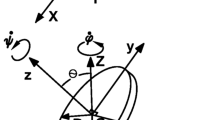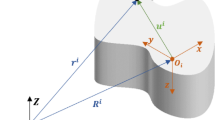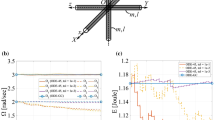Abstract
The model-based control design process for mechanical systems such as robotic vehicles and manipulators requires a clear mathematical model that describes the dynamics of the system to be available. Formulation of such mathematical models can be challenging especially if constraints are involved. There exist several methods of developing dynamic models for mechanical systems. The popular methods can be carried out in the natural inertial space, configuration space or in the quasi-coordinate space. Inertial space models such as those based on Newton-Euler formulation are only suitable for small systems because of the need to determine all unknown constraint reaction forces. Configuration space models such as Euler–Lagrange models are preferred to inertial space models because they reduce the number of unknown reaction forces into Lagrange multipliers where each constraint is associated with one Lagrange multiplier. However, these Lagrange multipliers also increase the dimension of the system and can be prohibitive if the system has many constraints. The most suitable alternative approach for multi-constrained systems is the use of quasi-coordinate space models such as the Maggi, Boltzmann–Hamel and the Gibbs–Appell formulations that eliminate the constraints altogether from the process. By doing so, they reduce the size of the working space compared to both the configuration space and the inertial space. Despite these advantages, quasi-coordinate space methods are not yet sufficiently popular in control design applications. The objective of this paper is to not only try to popularize the Boltzmann–Hamel and the Gibbs–Appell formulations but also to show that the two approaches are equivalent. Two examples are provided at the end to show this equivalence by yielding the same equations for the tested systems.


Similar content being viewed by others
Code Availability
The MATLAB code used in all examples is available by request to the authors.
References
Euler L, Mechanica Vol. 2 (1736). English translation by Ian Bruce at http://www.17centurymaths.com/contents/mechanica2.html
Lagrange JL, Mécanique analytique Vol. 2 (1789) English translation by Auguste Boissonnade and Victor N. Vagliente is available as Volume 191 of Boston Studies in Philosophy of Science Series released in 1997
Maggi GA (1896) Principii della teoria matematica del movimento dei corpi: corso di meccanica razionale (Ulrico Hoepli)
Maggi GA (1901) Di alcune nuove forme delle equazioni della dinamica applicabili ai sistemi anolonomi. Atti Acad Naz Lincei Rend Cl Fis Mat Nat 10(5):287–291
Kane TR, Levinson DA (1980) Formulation of equations of motion for complex spacecraft. J Guid Control 3(2):99–112. https://doi.org/10.2514/3.55956
Boltzmann L (1902) Über die Form der Lagrangeschen Gleichungen für nichtholonome, generalisierte Koordinaten, Vol. 3 of Cambridge Library Collection—Physical Sciences (Edited by F. Hasenöhrl), 682–692 (Cambridge University Press, 2012). Initially published in Sitzungsberichte der Kaiserlichen Akademie der Wissenschaften in Wien, No. 111, pp 1603–1614
Hamel G (1904) Die Lagrange-Eulerschen Gleichungen der Mechanik. Z Math Phys 50
Gibbs JW (1879) On the fundamental formulae of dynamics. Am J Math 2(1):49–64
Appell P (1925) Sur une forme generale des equations de la dynamique. Mémorial des Dciences Mathématiques, Fascicule 1 (Gauthier-Villars). https://doi.org/10.1515/crll.1900.121.310
Müller A (2021) On the Hamel coefficients and the Boltzmann–Hamel equations for the rigid body. J Nonlinear Sci 31(2):1–39. https://doi.org/10.1007/s00332-021-09692-7
Desloge EA (1988) The Gibbs–Appell equations of motion. Am J Phys 56(9):841–846. https://doi.org/10.1119/1.15463
Lewis AD (1996) The geometry of the Gibbs–Appell equations and Gauss’ principle of least constraint. Rep Math Phys 38(1):11–28. https://doi.org/10.1016/0034-4877(96)87675-0
Udwadia FE, Kalaba RE (1998) The explicit Gibbs–Appell equation and generalized inverse forms. Q Appl Math 56(2):277–288. https://doi.org/10.1090/qam/1622570
Greenwood DT (2006) Advanced dynamics. Cambridge University Press, ISBN-13:978-0521029933, https://isbndb.com/book/9780521029933
Baruh H (1999) Analytical dynamics. WCB/McGraw-Hill Boston, ISBN-13:978-0073659770, https://isbndb.com/book/9780073659770
Ginsberg JH (1998) Advanced engineering dynamics. Cambridge University Press, ISBN-13:978-0521646048, https://isbndb.com/book/9780521646048
Arczewski K, Blajer W (1996) A unified approach to the modelling of holonomic and nonholonomic mechanical systems. Math Model Syst 2(3):157–174. https://doi.org/10.1080/13873959608837036
Cameron JM, Book WJ (1997) Modeling mechanisms with nonholonomic joints using the Boltzmann–Hamel equations. Int J Robot Res 16(1):47–59. https://doi.org/10.1177/027836499701600104
Tarn TJ, Shoults GA, Yang SP (1996) A dynamic model of an underwater vehicle with a robotic manipulator using Kane’s method. Auton Robot 3(2):269–283. https://doi.org/10.1007/BF00141159
Altuzarra O, Campa Gomes F, Roldan-Paraponiaris C, Pinto C (2015) Dynamic simulation of a tripod based in Boltzmann–Hamel equations. In: 39th Mechanisms and Robotics Conference of International Design Engineering Technical Conferences and Computers and Information in Engineering Conference, vol 5C. https://doi.org/10.1115/DETC2015-47427
Maruskin JM, Bloch AM (2011) The Boltzmann–Hamel equations for the optimal control of mechanical systems with nonholonomic constraints. Int J Robust Nonlinear Control 21(4):373–386. https://doi.org/10.1002/rnc.1598
Jarzębowska E (2009) Quasi-coordinates based dynamics modeling and control design for nonholonomic systems. Nonlinear Anal Theory Methods Appl 71(12):118–131. https://doi.org/10.1016/j.na.2008.10.049
Jarzębowska E, Lewandowski R (2006) Modeling and control design using the Boltzmann–Hamel equations: a roller-racer example. IFAC Proc Vol 39(15):236–241. https://doi.org/10.3182/20060906-3-IT-2910.00041
Papastavridis JG (1994) On the Boltzmann–Hamel equations of motion: a vectorial treatment. J Appl Mech 61(2):453–459. https://doi.org/10.1115/1.2901466
Featherstone R, Orin D (2000) Robot dynamics: equations and algorithms. Proceedings 2000 ICRA. Millennium Conference. In: IEEE international conference on robotics and automation. Symposia proceedings (Cat. No. 00CH37065) vol 1, 826–834. https://doi.org/10.1109/ROBOT.2000.844153
Korayem MH, Shafei AM (2013) Application of recursive Gibbs–Appell formulation in deriving the equations of motion of N-viscoelastic robotic manipulators in 3D space using Timoshenko beam theory. Acta Astronaut 83:273–294. https://doi.org/10.1016/j.actaastro.2012.10.026
Korayem MH, Yousefzadeh M, Manteghi S (2017) Dynamics and input–output feedback linearization control of a wheeled mobile cable-driven parallel robot. Multibody SysDyn 40(1):55–73. https://doi.org/10.1007/s11044-016-9543-6
Mirzaeinejad H, Shafei AM (2018) Modeling and trajectory tracking control of a two-wheeled mobile robot: Gibbs–Appell and prediction-based approaches. Robotica 36(10):1551–1570. https://doi.org/10.1017/S0263574718000565
Vossoughi G, Pendar H, Heidari Z, Mohammadi S (2008) Assisted passive snake-like robots: conception and dynamic modeling using Gibbs–Appell method. Robotica 26(3):267–276. https://doi.org/10.1017/S0263574707003864
Náprstek J, Fischer C 2018) Appell–Gibbs approach in dynamics of non-holonomic systems. In: Nonlinear systems, Ch. 1. IntechOpen, Rijeka. https://doi.org/10.5772/intechopen.76258
Xiong J et al (2021) Reduced dynamics and control for an autonomous bicycle. 2021 IEEE International Conference on Robotics and Automation (ICRA) 6775–6781. https://doi.org/10.1109/ICRA48506.2021.9560905
Gauss CF (1877) Über Ein Neues Allgemeines Grundgesetz der Mechanik. In: Werke: Fünfter band. Springer, Berlin, pp 23–28. https://doi.org/10.1007/978-3-642-49319-5_2
Tufillaro NB, Abbott TA, Griffiths DJ (1984) Swinging Atwood’s machine. Am J Phys 52(10):895–903. https://doi.org/10.1119/1.13791
Funding
The work reported in this paper was not funded by any governmental or private agency.
Author information
Authors and Affiliations
Contributions
The two authors contributed equally in this work. Selekwa started investigating the equivalence of the two methods, and he assigned Pius to establish that equivalence by applying the two methods on different systems as part of a term project. Finally the two authors compiled the findings and decided to share them with the rest of the world through this manuscript.
Corresponding author
Ethics declarations
Conflict of interest
The authors declare that they have no known competing financial interests or personal relationships that could have appeared to influence the work reported in this paper.
Rights and permissions
Springer Nature or its licensor (e.g. a society or other partner) holds exclusive rights to this article under a publishing agreement with the author(s) or other rightsholder(s); author self-archiving of the accepted manuscript version of this article is solely governed by the terms of such publishing agreement and applicable law.
About this article
Cite this article
Pius, P., Selekwa, M. The equivalence of Boltzmann–Hamel and Gibbs–Appell equations in modeling constrained systems. Int. J. Dynam. Control 11, 2101–2111 (2023). https://doi.org/10.1007/s40435-023-01119-3
Received:
Revised:
Accepted:
Published:
Issue Date:
DOI: https://doi.org/10.1007/s40435-023-01119-3




